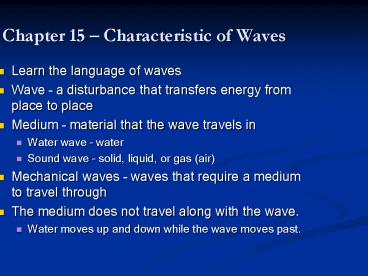Chapter 15 - PowerPoint PPT Presentation
1 / 13
Title:
Chapter 15
Description:
Chapter 15 Characteristic of Waves Learn the language of waves Wave a disturbance that transfers energy from place to place Medium material that the wave ... – PowerPoint PPT presentation
Number of Views:26
Avg rating:3.0/5.0
Title: Chapter 15
1
Chapter 15 Characteristic of Waves
- Learn the language of waves
- Wave a disturbance that transfers energy from
place to place - Medium material that the wave travels in
- Water wave water
- Sound wave solid, liquid, or gas (air)
- Mechanical waves waves that require a medium
to travel through - The medium does not travel along with the wave.
- Water moves up and down while the wave moves past.
2
- Amplitude height of wave
- Wavelength (?) distance between two
corresponding parts of a wave (crest to crest)
3
- Vibration repeated back and forth or up and
down motion that can create waves. - Transverse wave a wave that has crests and
troughs - Example a water wave
4
- Longitudinal wave a wave that has compressions
and rarefactions - Example a sound wave
5
- Frequency is the number of waves
made each second. (f waves/sec.) - Frequency is also the number of waves
that pass a given point each second. - 1 wave/sec 1 hertz (Hz)
- Speed wavelength (frequency)
- Speed
- Frequency
- Wavelength
- Speed
- Wavelength
- Frequency
6
- Example problem The speed of a wave on a
guitar string is 100 m/s and the frequency is
1,000 Hz. What is the wavelength of the wave?
7
Interactions of waves
- Reflection waves can bounce off an object
(like light off a mirror). - The angle of incidence the angle between the
wave and an imaginary line. - The angle of incidence the angle of
reflection.
the normal
Light
Mirror
8
- Refraction When light moves from one medium
into another it changes speed which causes it to
bend. - As the wave slows down it is bent towards the
normal. - As the wave speeds up it is bent away from the
normal.
Light ray
Air
Water
9
- Diffraction when a wave passes a barrier or
moves through a hole in a barrier it bends and
spreads out.
Waves
10
Waves can add or cancel
11
Wave Interference
- http//id.mind.net/zona/mstm/physics/waves/interf
erence/intrfrnc.html
12
- Constructive interference adding of waves
- Destructive interference canceling of waves
- Standing waves- when a reflected wave adds to an
incoming wave just right a stationary wave is
produced. - Nodes stationary points of standing waves
- Antinodes crests and troughs of a standing wave
13
Resonance
- Most objects have a natural frequency of
vibration. - Resonance is when the vibration passing
through the object matches the objects natural
vibration. (like pushing a child on a
swing. Energy input adds perfectly.)































